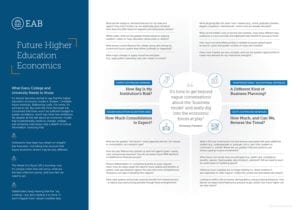When Amazon released its RFP for HQ2, we predicted that higher education would play an important role in the final decision. Given their requirements for population, transit, and culture, it was only natural that Amazon would gravitate toward regions that also had strong higher ed ecosystems and were prepared to train highly skilled employees and develop strong research partnerships.
Subscribe
Stay ahead of the latest trends, innovations, and out-of-industry ideas in higher ed.
Sign UpThe bids that rolled in from across the country, however, mostly focused on top-dollar tax incentives. Columbus, Ohio, promised Amazon that they could keep 35% of income taxes paid by Amazon employees, in addition to a 15-year property tax abatement; while Baltimore offered $6.5 billion in tax incentives plus $2 billion in infrastructure improvements. Other proposals were rumored to include perks like re-naming streets and setting aside free parking at airports.
The proposal that clinched HQ2 for Northern Virginia contained miniscule tax incentives by comparison. Instead, it promoted the strength of Northern Virginia’s colleges and universities and offered to invest even more into those institutions (and into tech education for K-12) in order to meet Amazon’s talent needs.
As part of our research into how colleges and universities must evolve to remain relevant to future students, the Higher Ed Strategy Forum team has conducted research interviews with many of the leaders involved with Northern Virginia’s winning pitch. We walked away with three lessons for higher ed strategy leaders.
1. Lead in developing the region’s talent strategy
Long before the HQ2 RFP came out, the colleges and universities in Northern Virginia were already working to understand and meet the economic needs of the region.
Through an organization called the Northern Virginia Technology Council, all 19 higher ed institutions in the region work with major employers to build partnerships and pathways for students. In early 2017, the Virginia Economic Development Partnership (VEDP)—the eventual architect of the winning proposal—began to write a strategic plan that would further strengthen partnerships between higher ed and local employers. The plan listed higher education as the region’s top strength but also as a top opportunity: It called for more investment in innovative pipelines between K-12, higher ed, and industry to meet the region’s talent needs in tech and science fields.
These collaborations between Northern Virginia’s higher ed institutions and local industry meant that VEDP already had a substantive understanding of the region’s strengths, and were already discussing strategies to better meet the region’s needs, when Amazon released its RFP. One of VEDP’s first moves was to organize a call with the area’s college and university leaders to think about how to prepare a proposal that centered around greater investment in higher education.
2. Think practically about regional talent needs
When considering new academic programs and pathways, it’s often tempting to look only at the current job openings in your own region to understand the market need. However, employers often simply need more employees that look just like the ones they currently have.
VEDP embraced this philosophy to better understand what characteristics and competencies future graduates of Northern Virginia higher ed would need to have if the region hoped to attract Amazon. They leveraged social media and other data sources to better understand talent profiles at Amazon’s current headquarters—and more broadly in the Seattle area—with the thinking that those profiles would be the best available predictors for the talent needs at HQ2.
3. Take a holistic perspective on economic opportunities
Even though Northern Virginia has now captured the big fish, the area’s higher ed institutions know they can’t—and shouldn’t—focus solely on training employees for Amazon.
Both George Mason University and Virginia Tech are in the process of building out innovation campuses near the HQ2 site in National Landing (originally called Crystal City). These campuses will educate the tech-related graduates that Amazon needs but will also provide commercial and incubator space for the start-ups and small businesses headed to Northern Virginia in Amazon’s wake.
One leader at George Mason pointed out to EAB researchers that Jeff Bezos himself founded Amazon in Seattle in order to take advantage of the talent infrastructure that served Microsoft. The next Jeff Bezos could likely be planning right now to move to Northern Virginia—and Virginia’s higher ed institutions are preparing themselves to provide the space, the research, and the education workforce those innovators will need.



